JAPANESE GUEST TEACHER
Kōgetsu MAEKAWA
Kogetsu Maekawa began playing Kinko ryū, Chiku yucca shakuhachi at the age of 18 and received his shihan license when he was 25. Three years later he began studying Fuke Zen shakuhachi with Okamoto Chikugai (1915-2000). Chikugai is considered one of the great mentors in shakuhachi of the 20th century, and also a great player and collector of pieces from various shakuhachi groups scattered around Japan. Like his mentor, Kogetsu is a member of the board of the Komusō Shakuhachi Study Group and has a great knowledge of the various ryū of the so-called Myōan group. He has shihan licenses from both Tsugaru Kinpū ryū and Myōan ryū. He teaches frequently Kinpū ryū in Hirosaki city in Aomori Prefecture – the place Kinpū ryū originates in order to assist the area’s effort in preserving and keeping alive the local art.
Maekawa is considered an outstanding player of the shakuhachi tradition that is somewhat regarded as a parallel world beside the hōgaku world e.g., the mainstream Japanese traditional music world with professional performers and teachers and their large gathering of amateur practitioners.
It is the first time a player from the Fuke Zen shakuhachi tradition will visit us at a European Shakuhachi Summer School. Kogetsu will teach pieces from Kinpū ryū, Myōan ryū and from the Echigo tradition. He will teach a particular breathing technique that is rarely used today called gyakufukushiki-tanden-kokyūhō (逆複式丹田呼吸法) – a technique in which the awareness lies on the abdominal point tanden (in Chinese: dantian). He will also speak about the history of Kinpū ryū.
More information here (only in Japanese):
www.cougetukai0115.net/index.html
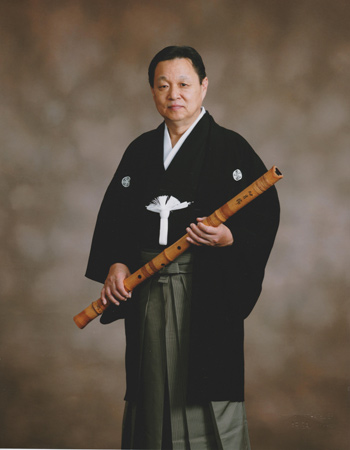
Kogetsu MAEKAWA
EUROPEAN GUEST TEACHERS
Wolfgang Fuyūgen HEßLER
Wolfgang Heßler belongs to a modern generation of musicians, who’s education and work is based not only on the music of one culture.
Grown up in Munich he studied doublebass with Herbert Duft and graduated from the Munich College of Music. Following he worked at the Orchestra of the State-Opera
(National Theatre Munich), the Munich Philharmonic and the Bavarian Radio Symphony-Orchestra, partly still during his studies.
In Switzerland Wolfgang Hessler studied the Japanese bamboo-flute shakuhachi in the tradition of the Kinko-School with Dr. Andreas Fuyû Gutzwiller at the Studio for extraeuropean Music of the Academie of Music Basel. Several journeys to and study visits in Japan took him to Kawase Junsuke III, head of the Zenkoku Chikuyusha in Tokyo, who performed the Shihan-Menyô-Ceremony for him to confirm the reception of the tradition. In addition, Wolfgang Hessler studied with Nobuhisa Ikkei Hanada in the tradition of the temple Itchôken (Hakata/Kyûshu) and with Yousuke Kawase the Honkyoku of the Nezasaha Kinpu Ryu.
Wolfgang Hessler lives and teaches in Zurich, performing in concerts and recitals traditional Japanese music (honkyoku and gaikyoku) and modern music as well as with improvisation ensembles.
Influenced by Sergiu Celibidache, affected by the practice of playing the shakuhachi as an exercise in concentration and respiration of the Fuke-monks in Japan, he dedicates his activity to the spiritual dimension of making music. Leaving behind any concept and construct, any will and intention, making music happen as activity in alertness and concentration, guided by one’s proper breath and the almost unexhaustable tone colour of the shakuhachi.
IT plays. This is not extraneous to western music, but hardly anyone knows about that nowadays.
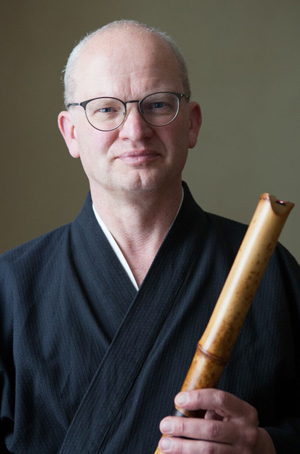
Wolfgang HEßLER
Hélène Seiyu CODJO
Hélène Seiyu Codjo started to learn shakuhachi with Daniel Seisoku Lifermann in Paris in the French association ‘La Voie du Bambou’. Since 2006, she regularly attends the masterclasses of Fukuda Teruhisa, founder of the ensemble and school Hijiri-Kai. In January 2013, she received the jun-shihan license with the name Seiyu 聖 優 (Wisdom of kindness) from him. In November 2015, Fukuda Teruhisa awarded her with the shihan license (master).
She lives in the Netherlands, where she gives lessons (Nijmegen, Rotterdam), workshops and concerts.
Furthermore, she performs in shows where she plays other world flutes in addition to the shakuhachi and the western flutes. She has recorded a dozen CDs for children with her different flutes and regularly works with storytellers.
www.hijirishakuhachi.wordpress.com (dedicated to the Hijiri-ryū school and style)
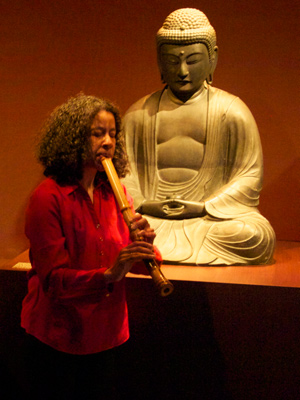
Hélène Seiyu CODJO
Gunnar Jinmei LINDER
Gunnar Jinmei Linder began to study the shakuhachi at his arrival to Japan in 1985 under the living national treasure Yamaguchi Gorō (1933–99) head of the Chikumeisha guild of Kinko-ryū Shakuhachi.
He received his MA degree as shakuhachi soloist in 1997 at the Tokyo National University of the Arts and received his traditional license, shihan , and the name Jinmei (儘盟) from Yamaguchi sensei in 1998.
From 1997 to 2005 Gunnar was professionally active as performer and teacher of shakuhachi in Japan with frequent activities both in Europe and the US.
He moved back to his native Sweden in 2005 where is actively performing and teaching shakuhachi and working as Associate Professor in Japanese Studies at the Department of Oriental Languages of the Stockholm University conducting research in the traditional genres of Japanese music and a senior lecturer of shakuhachi at the Royal College of Music in Stockholm.
He has recorded several CDs, one instructional video/DVD and is author of the book Notes on Kinko-ryū Shakuhachi Honkyoku — Performance Techniques: Analysis, Classification, Explanation, as well as his PhD dissertation Deconstructing Tradition in Japanese Music: A Study of Shakuhachi, Historical Authenticity and Transmission of Tradition.
More information at: nipponicom.com/shakuhachi

Gunnar Jinmei LINDER
Suizan LAGROST
Suizan J.-F. Lagrost is professor of art education at the conservatories of Le Kremlin-Bicêtre and Asnières. As a versatile musician, he excels in both the Western and Japanese musics. After a traditional curriculum of concert flute in Mulhouse and Paris, then a DEA of Music of the 20th century at the University of Paris-Sorbonne, he began the shakuhachi in 2000 (Tozan style) and obtained in 2014 the title of dai-shihan (grand master).
The diversity of his expertise conducts him to appear in a variety of backgrounds : the Ensemble de flûtes de Paris, flute & piano recitals in Taiwan, as a soloist with the Musique de la Garde républicaine, as well as Summer Schools and Festivals of shakuhachi in Europe (Barcelona, Prague, etc.) He published in 2013 a Japanese chamber music CD entitled “Kyoku” with the koto player Mieko Miyazaki.
As a Senior Advisor of the European Shakuhachi Society, he has founded and administered since 2011 the world main forum of shakuhachi www.shakuhachiforum.eu.
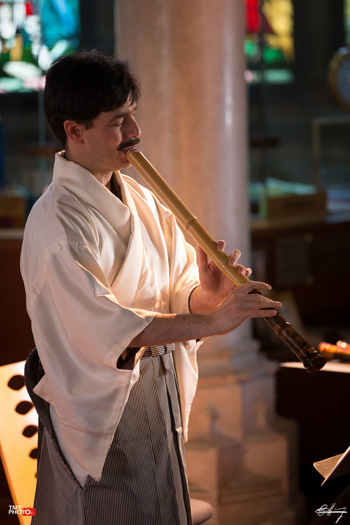
Suizan Lagrost
Véronique PIRON
Véronique Piron, a French flautist based in West of France (Brittany), is a shakuhachi master-performer in the style transmitted by Yokoyama Katsuya (KSK) who awarded her a shihan-licence in 2002 while recipient of a Lavoisier research grant from the French government for studying in Japan.
She participated in the creation of the ESS and developed the teaching of the shakuhachi primarily in the style of the KSK in Brittany and Paris. As a licensed conservatoire teacher for traditional music she is also introducing Japanese music in the French conservatoire system and higher education.
From tradition to creation, Véronique Piron is widely produced in a solo program (CD Nipponflutes, 2010), or in an intercultural new music program with pianist Lydia Domancich (CD Sillage (Wake) 2015), is starting a new classical trio Yuya with the koto/shamisen players Fumie Hihara and Etsuko Chida, meets with composers for new music, and meets with other musical cultures (Twain, an international project with taikos started in 2016, celtic fusion with Alan Stivell 2015, etc).
www.veroniquepiron.com

Véronique PIRON
Dr Jim FRANKLIN
Dr Jim Franklin is a master performer of the shakuhachi. Now resident in Germany, he initially studied composition and musicology in Australia, Germany and Holland. During his studies he encountered the shakuhachi, and was fascinated by it. After learning the instrument in Australia with Dr Riley Lee and in Japan with Furuya Teruo and Yokoyama Katsuya, he received the title shihan (“master”) in 1996 from Yokoyama-sensei, and was thus officially licensed to teach and perform shakuhachi.
As a composer, Franklin is active in the areas of contemporary and electroacoustic music, composing for shakuhachi solo and in combination with other instruments including live electronics. In the area of solo shakuhachi, Franklin has specialized in the honkyoku of the Kokusai Shakuhachi Kenshukan and in modern music.
From 2006 to 2009 he was founding Chairperson of the European Shakuhachi Society.
More information: www.bambooheart.com
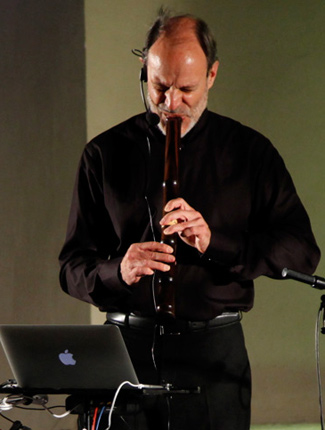
Dr Jim FRANKLIN
David HUGHES & Gina BARNES
David Hughes is a min’yō expert and taught music at SOAS (The School of Oriental and African Studies, University of London) from 1987-2008. He is now a Research Associate at SOAS and at Durham University.
In 2011 he received the annual Japan Society Award for “outstanding contributions to Anglo-Japanese relations and understanding” for his activities in bringing traditional Japanese music to a wide public. He founded the London Okinawa Sanshinkai and the SOAS Min’yō Group, the major groups performing and teaching traditional Japanese folk music in the UK.
His major publications include the books Traditional Folk Song in Modern Japan (2008) and the co-edited Ashgate Research Companion to Japanese Music (2008). David has lived for over ten years in Japan, his main research area, but has also written about aspects of music in Java, Thailand and Korea, as well as about musical grammars and oral mnemonics.
Gina Barnes has been married to David since 1975 and has shared in his journey around the world of Japanese music. She is a leading figure in Japanese and East Asian archaeology, as reflected in her recent book Archaeology of East Asia: the rise of civilization in China, Korea and Japan and her founding of the Society for East Asian Archaeology. She taught for 24 years at Cambridge and Durham Universities and has produced over a hundred publications.
In 1981 Gina received her geimei, Tōsha Keihō, from her teacher of shinobue and nōkan flutes, Tōsha Suihō I (now Tōsha Meishō II). She enjoys singing and accompanying min’yō.

Gina BARNES & David HUGHES
Kiku DAY
Kiku Day is a jinashi shakuhachi player from Denmark with Japanese and American background. She gave up her studies in classical Western music on flute to study honkyoku (classic solo repertoire of the komusō monks of the Fuke sect of Zen Buddhism) with Okuda Atsuya in Japan for 11 years.
Day has since her return to Europe dedicated her life to the potential use of jinashi shakuhachi today. The jinashi shakuhachi is the older type of shakuhachi, only consisting of the raw untreated bamboo. Several composers from different parts of the world have written for her, among others: Takahashi Yūji, Roxanna Panufnik, Frank Denyer, Vytautas Germanavicius and Yumi Hara Cawkwell. She has performed with performers such as Fred Frith, Joanna MacGregor, Mats Gustafsson and Joëlle Léandre, and as a soloist with Odense Symphony Orchestra and with the Nonsuch Choir.
Day has a Phd. in ethnomusicology from SOAS, University of London and has worked as an assistant professor at Aarhus University, Denmark. She is a founding member of the European Shakuhachi Society for which she now serves as chairperson.
More information at: www.kikuday.com

Kiku DAY
Naoko KIKUCHI
Born in Sendai, Japan. as a child, Naoko Studied koto with her grandmother and mother. She took lessons from Tadao Sawai and Kazue Sawai. Naoko received honor prizes from several contest subsequently. In 2007, Naoko received a year-long fellowship from the Japanese Government`s “Overseas Study Programme for Artists” to work in in Frankfurt, Germany, where she currently is a member of IEMA (International Esemble Modern Academie).
Her repertoire extends not only to classic and contemporary koto music, she is also a versatile artist who participates in a variety of projects, such as in “Move the international Berlin”, a project of the Berlin Philharmonic, or even at the new edition of “Barcelona” by Freddie Mercury & Montserrat Caballé, in the Gene Coleman composed music for silent films to “Page of Madness” or the premiere of a dance opera at the Deutsche Oper am Rhein music by Adriana Hölszky, it is just a small part.
She is voice president of Seigen koto school in Akita, Japan.
More information at: www.naokokikuchi.com

Naoko KIKUCHI
LECTURERS
Torsten OLAFSSON
The Zen Shakuhachi Truth Research Project, Denmark
Finding and unveiling the hidden, ignored, secret, fabricated or falsified texts and pictures … What to do with them – How to present and share them?
A presentation by Torsten Olafsson, Musician & Japanologist
Please see PDF for full details and summary of Torsten’s lecture.
Torsten Olafsson, born in 1950 in Copenhagen, Denmark, is a highly respected, broadly talented personality in the contemporary music world of Denmark. Already as a child a gifted multi-instrumentalist, in 1968 he co-founded the legendary symphonic prog rock band ACHE and created the world’s very first genuine beat/rock ballet named “De Homine Urbano”. The original 1969 recording of that unique work has since been reissued on both vinyl and CD again and again, most recently in 2012 by Esoteric Recordings, England.
Torsten Olafsson is an academically trained Japanologist, as well. In 1968, also, he first enrolled as a Copenhagen University student of Chinese Language, Culture, Arts & Music. Soon, a few years later, under the mesmerising influence of Yamaguchi Gorō’s LP A Bell Ringing in the Empty Sky, in 1974, Torsten decided to change course and study Japanese at The East-Asian Institute in Copenhagen. His prominent teachers in Japanese Language and Literature there were the three internationally renowned, now retired professors Dr. phil. Olof Lidin (Copenhagen a.o.) and Dr. phil., University Dean Kirsten Refsing (Hong Kong, Copenhagen, Aarhus, Asahikawa), as well as professor Esperanza Ramirez Christensen, PhD from Harvard University, 1983, as of now Professor Emerita of Japanese Literature, University of Michigan, USA.
Torsten Olafsson studied Myōan Taizan-ha shakuhachi with Ozawa Seizan in Kyōto and Kinko-ryū shakuhachi with Yokoyama Katsuya in Chiba. His 1983 LP/MC Standing Waves – Zen Shakuhachi Meditations (Olafssongs OLP/OMC 001) was reissued on CD in 2001 by Fønix Musik, Denmark, and is now being ranked as a genre bestseller.
Torsten’s MA thesis Kaidō honsoku, 1628. The Komosō’s Fuke Shakuhachi Credo. On Early 17th Century Ascetic Shakuhachi Ideology – submitted to the University of Copenhagen in 1987 – was published internationally by Tai Hei Shakuhachi, Willits, California, in 2003. Torsten’s ongoing critical research in the textual and pictorial evidence of early ascetic shakuhachi history, ideology and practice, especially, is continuously being published on his website www.zen-shakuhachi.dk
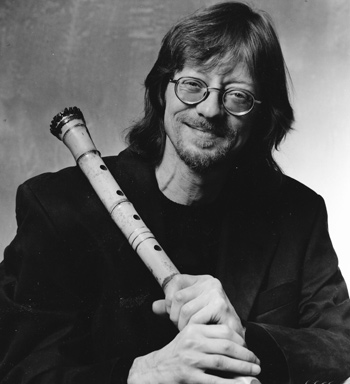
Torsten OLAFSSON
Jose Seizan VARGAS
Musician and guitar player, Jose Vargas began studying shakuhachi in 2004 with Antonio Olias in Madrid while at the same time begins to experiment with shakuhachi making.
From 2008, he travels to Japan, taking lessons from various teachers including Tanaka Koumei, Atsuya Okuda, Chiku Za, and Etsuzan Fujiyoshi, head of Fuke School from whom he received the licence to teach, and the name Seizan.
José’s jinashi making journey begins with lessons with Chiku Za and John Kaizan Neptune in 2008. And last year he has begun studying jiari shakuhachi making with Takahashi Toyomi in Tokyo.
José has organised, assisted and led jinashi shakuhachi making workshops in Europe, with Chiku Za since 2010 – in Madrid and at several ESS Summer Schools most recently at Summer Schools in Paris 2015 and Barcelona 2016.
During all these years, he also received valuable playing lessons from other teachers such as Horacio Curti, Justin Senryu Williams, Kakizakai Kaoru, Jim Franklin, Teruo Furuya, and lately he began receiving lessons from Keisuke Zenyouji.
Currently, he lives in Madrid, making jinashi flutes, teaching shakuhachi playing, and performing traditional Japanese and improvised music.

Jose Seizan VARGAS
Harald ANTES
Shakuhachi 2 Synth Project
The aim of this project is to provide shakuhachi players with the means to control an analogue synthesizer simultaneously with playing the shakuhachi, without affecting the playability of the flute.
So far it consists of three main modules: the pitch-to-voltage converter, the envelope follower and the “E-Shak”. The pitch-to-voltage converter derives a voltage from the pitch played on the shakuhachi. This is used primarily to control the pitch of the VCO (which is the initial generator of waves in the synthesizer). The envelope follower provides a voltage which follows the volume of the shakuhachi, together with gate and trigger signals. These are used mainly in conjunction with the synthesizer’s VCA (which is responsible for the dynamics of the synthesizer’s signal). The “E-Shak” is an exoskeleton attached to the shakuhachi with crepe tape. It is equipped with an accelerometer with three axes and with three switches. This module provides three control voltages according to the movement of the shakuhachi, and three additional on/off switches. The usage is only limited by the player’s imagination.
The Synth 2 Shak is a work in progress, the evolution of which is ongoing. There will be a dedicated website for this project in the near future. The link will show up at www.haraldswerk.de, and will be announced in the blog of Harald Antes.
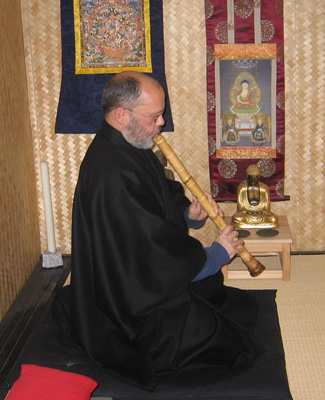
Harald ANTES
